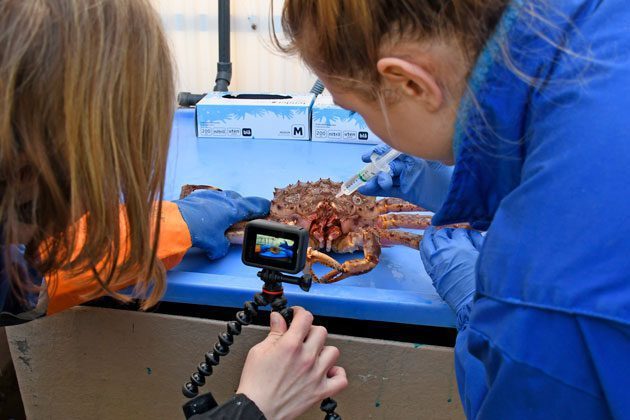World leaders in interdisciplinary crab research

Nofima has a world-leading interdisciplinary research environment for the delicacy that will spearhead Norwegian seafood exports: Crab.
“We track both king and snow crab from the harvest grounds to the global market, and have a unique network of collaboration partners”, says Sten Siikavuopio.
-“Nofima’s research mainly focuses on exploiting as much value as possible from the resource which both king and snow crab represent”, says Grete Lorentzen.
Both are senior scientists in Nofima and play a key part in the extensive and broad research work that is carried out on the two relatively new marine species in Norwegian fauna.
According to the Norwegian Seafood Council’s general strategy, shellfish should spearhead Norwegian seafood exports and help position Norway as the world’s leading seafood-producing nation. In 2018, king and snow crab exports amounted to NOK 740 million, and all indications are that this figure will continue to grow.
Bite-sized facts
To show the breadth on our research on crab, we will give a brief presentation of the various ways in which Nofima scientists are working with this valuable delicacy – and why:
• Catch: 70 per cent of the king crab harvested from Norwegian harvest grounds is exported alive to the global market – mainly the EU, USA and Asia. Scientists work in collaboration with fishermen to develop gentler catching methods – both for minimizing damage to the catch and for better animal welfare. Scoring systems for assessing the animal’s welfare have been developed, indicating stressors which the crab has been subjected to, as well as how well it can withstand the catch and transport processes.
• Live storage and transport: How should the crab be kept alive after the catch? And how to safeguard animal welfare while the crab is being transported by ground and air? Water quality, temperature, feed access, light and space are all important factors.
• Market: Crab is a relatively new product for Norwegian manufacturers, but not for the international market. Snow and king crab are especially popular in markets physically and culturally far removed from Norway. What market opportunities and requirements apply? How can we position and differentiate Norwegian crab towards international buyers to create both increased value and steady demand?
Fast and accurate
• Processing: It is vital to retain quality during handling and processing of the crabs. We have conducted investigations into how different steps in processing, such as heat and high pressure treatment, packing, freezing and thawing, affect the product. The goal is to find combinations of processing methods that yield a product with an optimum smell, taste and texture.
• Meat content measurement: Effective methods for measuring meat content in live crab legs is key in sorting the catch and determining the right price. Manual methods for this are both time-consuming and inaccurate. Nofima has partnered with industry stakeholders to develop a measuring instrument using near-infrared light to gauge the meat content in crab legs quickly and accurately, without damaging the alive animal.
• Feed: After years of trial and error at Nofima’s feed technology centre in Bergen, we have managed to develop a feed tailored for shellfish. In addition to having the right nutritional properties, the feed must also be of very high technical quality to reduce feed waste. Unlike salmon feed, which is consumed right away, shellfish feed needs to be stable in water for longer periods of time without crumbling or dissolving, and must be chewable. It is very demanding to produce feed pellets which have a high water stability, the right texture and good sinking properties.
• Genetics: Both king and snow crab change shells several times during their growth period. The quality of the meat changes dramatically in the time immediately preceding moulting. It is therefore important for manufacturers to be able to determine where in the moulting cycle the crabs are. Scientists have identified the Y-organ and Halloween genes that regulate the moulting cycle.
• Residual biomass: It is important to exploit the entire animal – not just the meat in the legs. Both valuable chitin and marine oils can be found in the shells and internal organs of crabs. Chitin can be utilized in medicine, in dietary supplements, for water purification or as a fungicide in various uses such as in beauty products, fertilizer or agricultural pesticides. At Biotep, Nofima’s national centre for bioprocessing, it is possible to run experiments on both a trial and industrial scale.
• Regulatory frameworks: The government sector sets down the framework for the industry’s value creation potential. King crab regulations have been revised several times, partly in order to contribute to a more market-oriented harvest. Regulations on crab fishing are constantly being developed. Nofima contributes to government policy development in order to facilitate the creation of an optimum value chain.
A solid foundation
“Farming is the latest step in crab research. It is very interesting for researchers, the business community and the market. We have only begun to scratch the surface in this regard, but due to the breadth of our research, we have established a solid foundation to build on”, says Siikavuopio.

